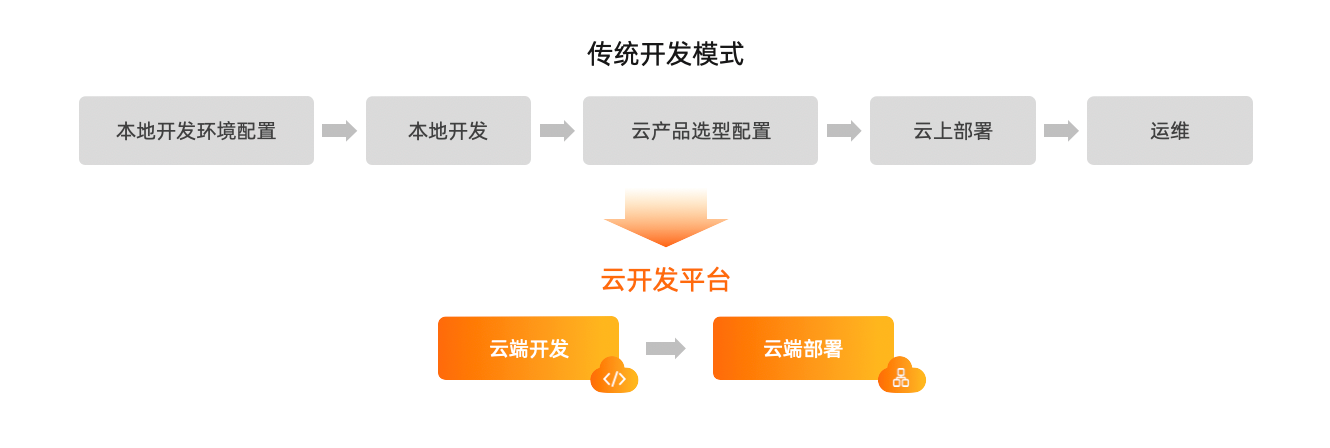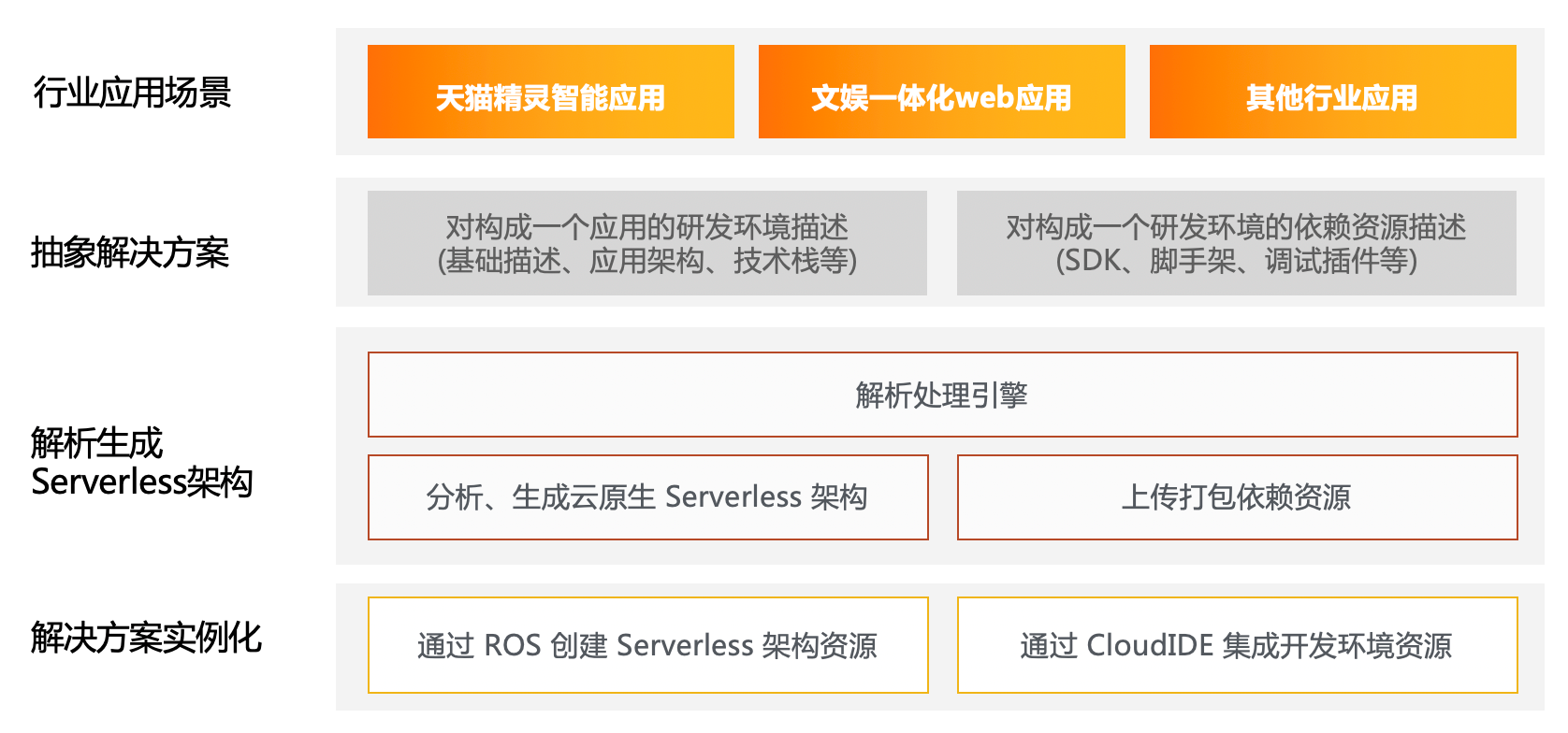From the traditional cloud service development model to the cloud development platform model, can this play a diversion role for Alibaba Cloud?
Editor: Shi Yaqiong
I learned that on June 9, the Alibaba Cloud development platform was officially launched. The platform is built on Alibaba Cloud Serverless and is a one-stop, all-cloud development platform for individual developers and SMEs.
According to data released by IDC, from 2014 to today, Alibaba Cloud has gradually surpassed Google and IBM, firmly secured the position of the world’s third largest cloud vendor, and ranked first and second. Amazon and Microsoft are called “3A” vendors in the international cloud computing market. According to Canalys statistics, Alibaba Cloud’s market share in China is 45.4%, which is 2.58 times that of the second place.
With the frequent efforts of big manufacturers and the rapid growth of the cloud service market, application development will gradually move to the “cloud + end” service model, and cloud computing will become the infrastructure of society. Du Huan, head of the cloud development platform, told me that Many of the underlying services in the future will be completed on the cloud, and applications and interactions will be resolved on the user side, which will bring about the evolution of the development model The evolution of the “cloud + end” development model is more significant for the front-end development industry and the innovation and entrepreneurship environment.
The vision of Alibaba Cloud Cloud Development Platform is to help developers use cloud computing capabilities more efficiently and at lower cost, and provide users with out-of-the-box cloud computing services.
Du Huan told us that the current pain points in the cloud service industry mainly come from three aspects:
1. Many cloud service vendors have a lot of cloud capabilities including computing, storage, network, etc. There are many types, even if there are countless similar products under the same service type.
So when developers are going to choose products for business, the learning cost is very high. Developers often need to compare products from different vendors. Even for many small and medium-sized enterprises and individual developers, they do not have the ability to distinguish products, and they need to learn cloud service products for their business. This process often requires high costs and cannot achieve the integration of cloud service products and services.
2. Startup companies cannot obtain low-cost and sustainable support for architectural services. For those users who need business development and a large number of rapid trial and error operations, if they want to ensure sustained high-speed business growth, there is not enough time to pre-think the architecture. If there are defects in the architectural design, the future products will not be able to support huge traffic after going online.
The time window is notTolerable to miss, from an idea to the actual implementation to go through the development of business logic, joint debugging test, online deployment and other processes in several sets of environments. These processes often take days or longer, and developers worry about missing the window period. From testing to landing, there will be an explosive increase in access users, and CPU resources, memory, bandwidth, and connection pools will easily cause downtime without strict development calculations.
3. Small and medium-sized enterprises have a higher cost of obtaining a suitable architect. The current architect resources in the industry are mainly concentrated in the head vendors. For start-ups and small and medium-sized enterprises, the relative cost of using architects is too high. In the industry, it is common to let positions that are good at the development side to learn and complete the corresponding work, and the efficiency is generally not high.
Alibaba Cloud development platform caters to the current major pain points of cloud services, simplifies the process for users to use cloud services, and combines real-time elasticity and pay-as-you-go to ensure the stability and low cost of user cloud services. In addition, the cloud development platform ClouldIDE has built-in common development environments such as Node.js, Java, Python, and PHP. Users can develop, debug, and launch applications by opening the browser. This can also win customers for Alibaba Cloud services. Play the role of diversion.
Image source: Interview for illustration
The main business process of the Alibaba Cloud development platform starts from the user logging in to the cloud development platform. The user can select a solution application template in the “scene” to create an application and develop it, and finally deploy and debug in different environments such as daily, pre-release, and online 1. Online application. In addition, the Alibaba Cloud development platform will also open the industry solution market, and development service providers in the industry can also enter the platform to provide out-of-the-box services for more industry application development ecology.
Du Huan told: “When the cloud development platform analyzes a solution, the core will do two things, one is to analyze and generate a cloud-native serverless architecture based on the Alibaba Cloud product matrix, and the other thing is to rely on Resources to do preprocessing such as packaging and uploading; then start generating tasks, one by one to produce, create, install, until an industry application is initialized, using the technical language to analogy, this is the “serialization and deserialization of application cloud services” Process”.
Image source: Interview for illustration
According to the types of services, existing cloud computing is divided into IaaS (Infrastructure as a Service), PaaS (Platform as a Service) and SaaS (Software as a Service). The difference between these three types of services is the continuous extension of services. The business scope of the Alibaba Cloud development platform covers these three types of services. However, both PaaS and SaaS services need to be settled on IaaS. In the early days, a large number of enterprises often purchased a lot of IaaS services, so the current cloud service business is still focused on IaaS. According to iResearch data, the size of China’s IaaS service market reached 63.82 billion yuan in 2018, while the PaaS market relied on significant growth in the fields of containers, databases, cloud communications, etc., showing a relatively high market prospect. There are still major doubts about the SaaS service model in China, and with the continuous expansion of the basic cloud application field and the improvement of vendor services, my country’s cloud computing services will still focus on IaaS+PaaS services in the next few years.
Developers need a simpler cloud service model. Sometimes they need to manage accounts of multiple cloud service providers to operate, which also promotes the birth of the multi-cloud management platform (CMP). Currently, there are multi-cloud management platforms such as Xingyun Butler and Boyun. Although platforms such as Xingyun Butler do not provide direct cloud services, their support includes services from mainstream cloud service vendors such as Alibaba Cloud, AWS, Azure, and Huawei Cloud, and it can improve the expansion capabilities of the platform through plug-in iterations. Currently, Xingyun Butler has more than 70,000 enterprise-level registered users. Alibaba Cloud development platform said that in the future, it will also connect more manufacturers’ open products and services.

